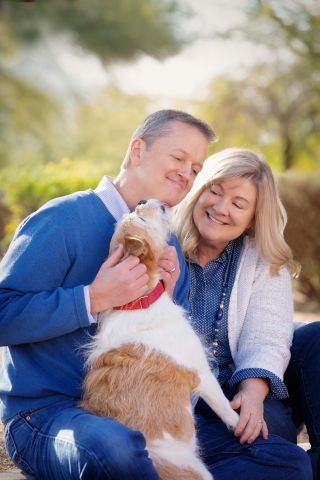Therapy
When a Therapy Dog Dies
A Personal Perspective: The news of my dog's passing spread fast.
Posted May 24, 2023 Reviewed by Lybi Ma
Key points
- Grieving is a form of learning, one that teaches us how to be in the world without someone we love in it.
- Grief triggers the sympathetic fight-or-flight system that raises a sense of panic.
- The gift of a therapy dog: They help settle a human's nervous system through a glance or a touch.

My therapy dog died, and I’m heartbroken. Gretel was a very special dog; ask anyone who met her. The news spread fast of her passing, and the outpouring of love from neighbors, friends, family, pet sitters, other therapists, and yes, clients over the last 10 years, has been overwhelming. Even her foster mother from the rescue organization reached out via social media. We’ve all shared pictures, memories, and tears. One family member from Australia writes, “I catch myself thinking of Gretel several times a week. It’s more of a rapid wave of appreciation and joy than a concrete thought. A feeling of simple and pure love. She will be a part of me for the rest of my life.”
Grief and the brain
Mary-Frances O’Conner, Ph.D., author of The Grieving Brain, explains that grieving is a form of learning – one that teaches us how to be in the world without someone we love in it. The neurobiology of grief comes from snapshots that are tied to so many brain functions, from recalling memories to regulating our nervous system. Our brain looks for certain cues of regulation tied to the familiar, such as the sound of her sweet snoring in the bed next to me. Waves of grief are triggered when I find myself moving carefully to avoid stepping on her when she is no longer underfoot or looking for her at the gate as I enter the garage, knowing that feeling will never be repeated. My nervous system expects it, and I will need to train it to expect another form of regulation. Grief is the fear of never experiencing love in that special way that only they could make you feel.
Grief triggers the sympathetic fight-or-flight system that raises a sense of panic. I feel it in my heart; I feel it in the gut. The body reacts fiercely telling us it needs reassurance, a feeling of safety and connection, and some love serum (oxytocin) to reset to our parasympathetic state. Love is a biological imperative according to the polyvagal theory. Our autonomic nervous system is wired to look for safety in others. In this case, I’m screwed because Gretel was the co-regulator.
The gift of a therapy dog

The gift of therapy dogs (or dogs that were born therapists) allows them to help settle a human’s nervous system through a glance, a touch, and playful and social interactions. They have a calming presence. The connection humans and dogs have is a powerful one. Pedigree shared a video on YouTube several years ago called Hearts Aligned, which demonstrated being close to your dog changed both the dog's and owner's heart rate variance (HRV) to a calm and coherent pace. Quite literally, therapy dogs are super co-regulators.
Gretel retired from coming to the office every day a couple of years ago, so my current caseload has not been traumatized by sudden death. We knew she was failing, her quality of life fading, but an inoperable tumor is what ultimately took her life. It burst open, and she gave us a look that said, “It’s time.” Surrounded by love, she peacefully went to sleep and crossed over the Rainbow Bridge.
She was the best dog ever. I continue to allow spontaneous tears, as they naturally release the stress hormone cortisol and replace it with oxytocin. I will train my brain to look for other co-regulators first. I must admit: I was the wife who greeted the dog before my husband. I don’t think this is uncommon. In our house, the dog was, quite literally, god spelled backward. The empty nest will improve my marriage.
References
O’Conner, Mary-Frances (2023) The Grieving Brain. The Surprising Science of How We Learn from Love and Loss. Harper One.
Porges SW (2021). Polyvagal Safety: Attachment, Communication and Self-Regulation. New York: WW Norton.


